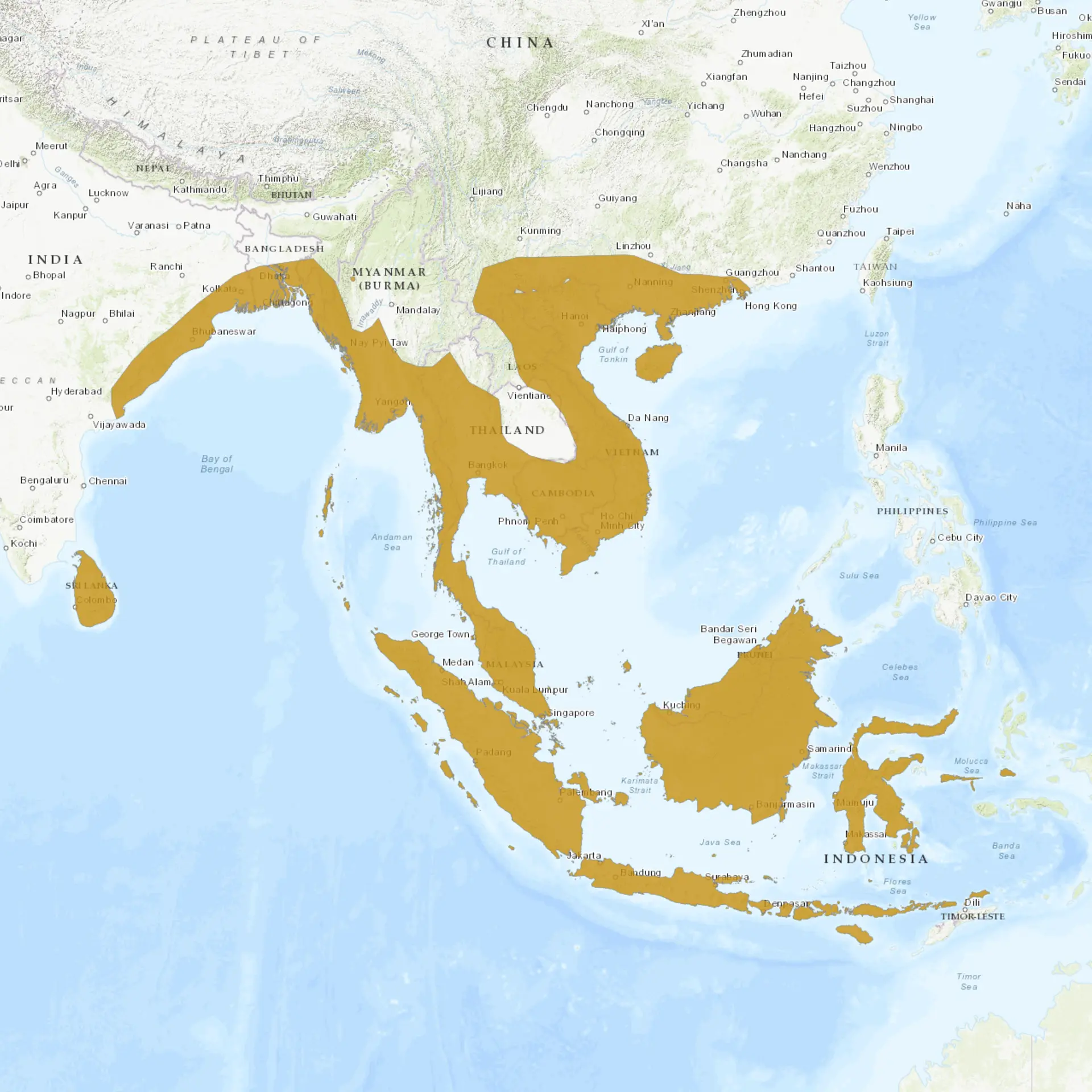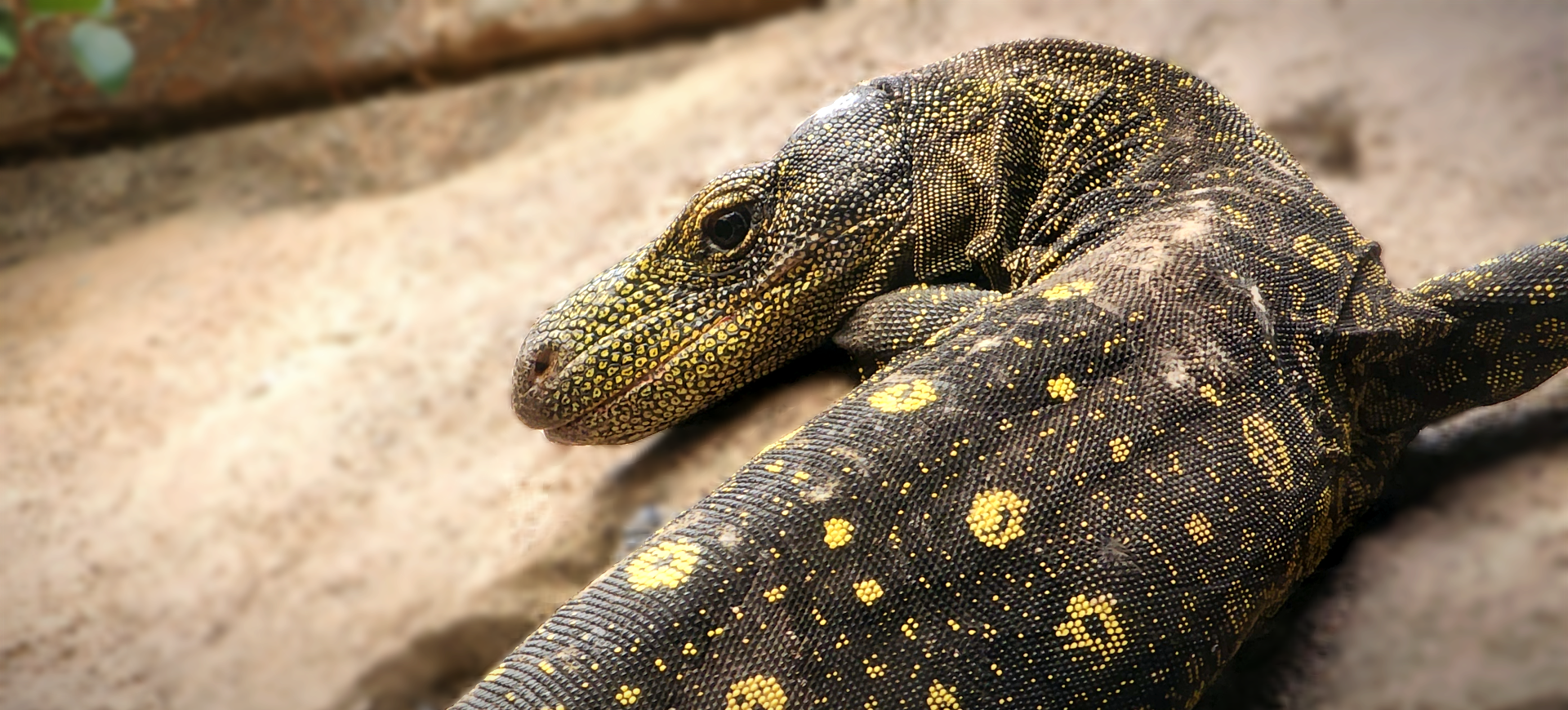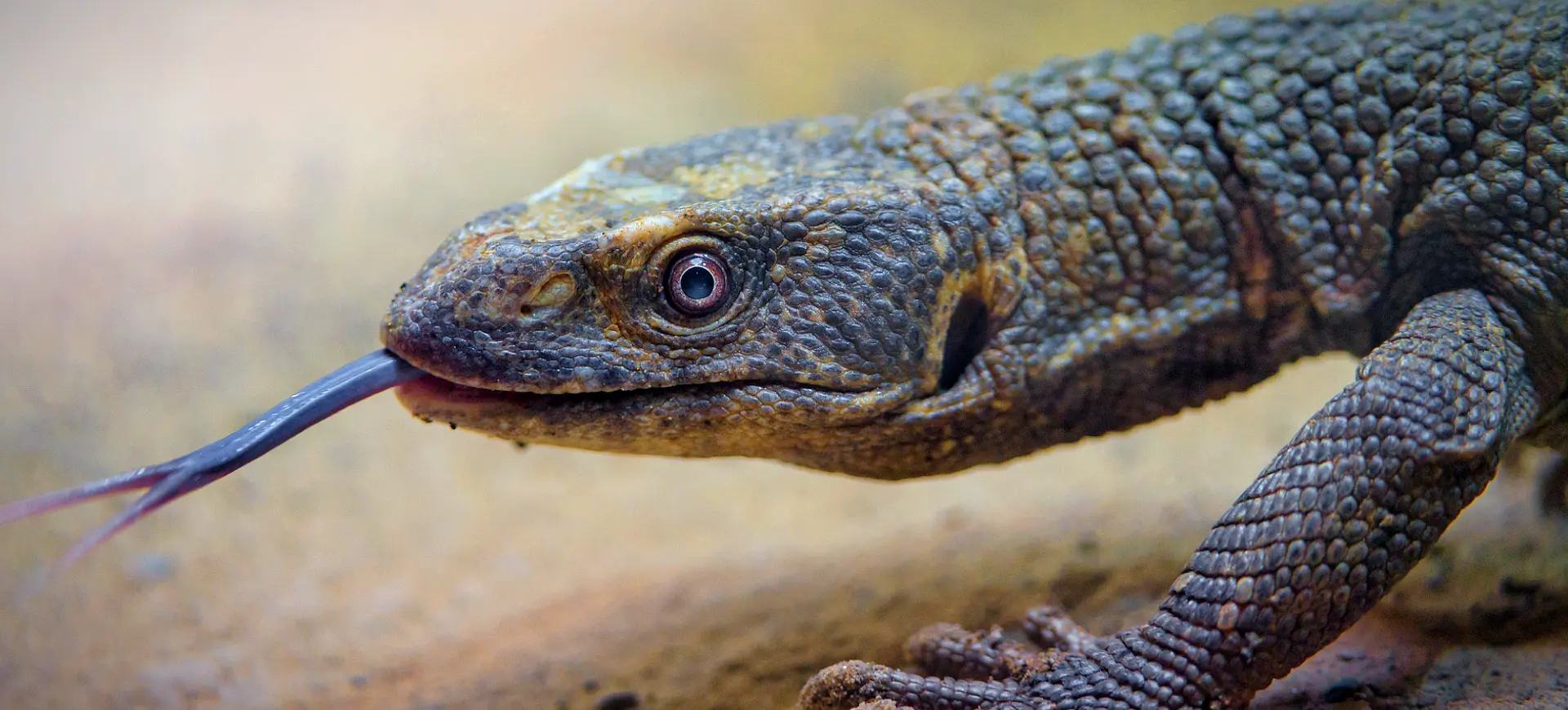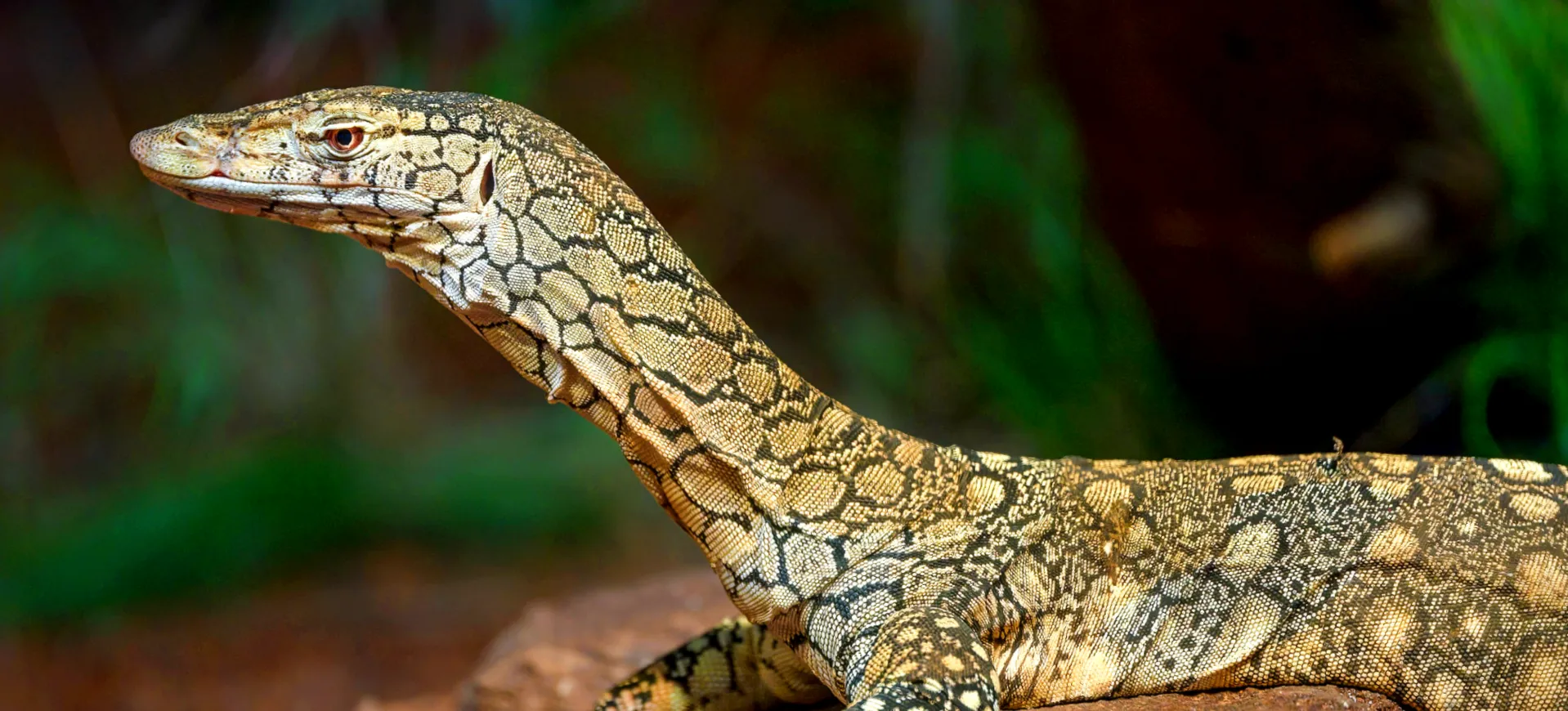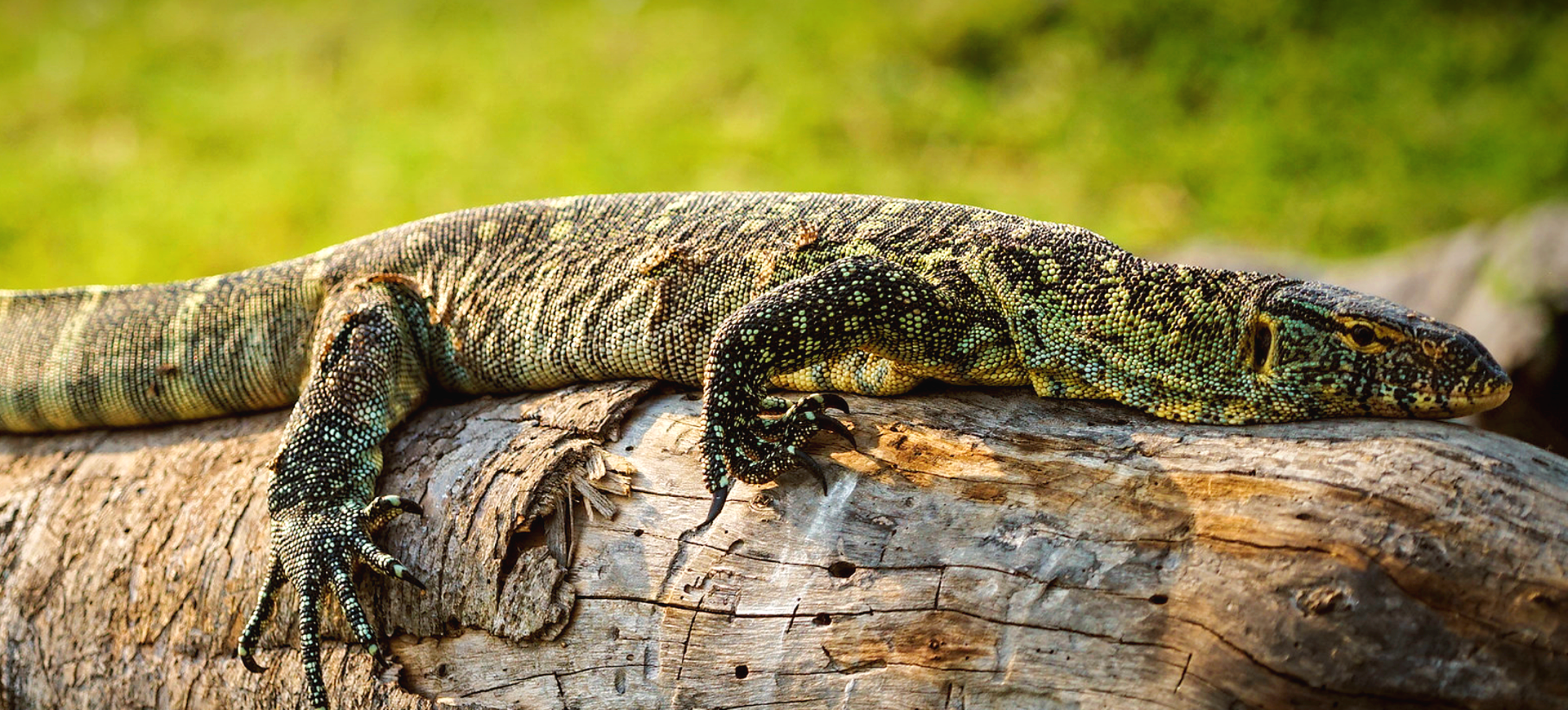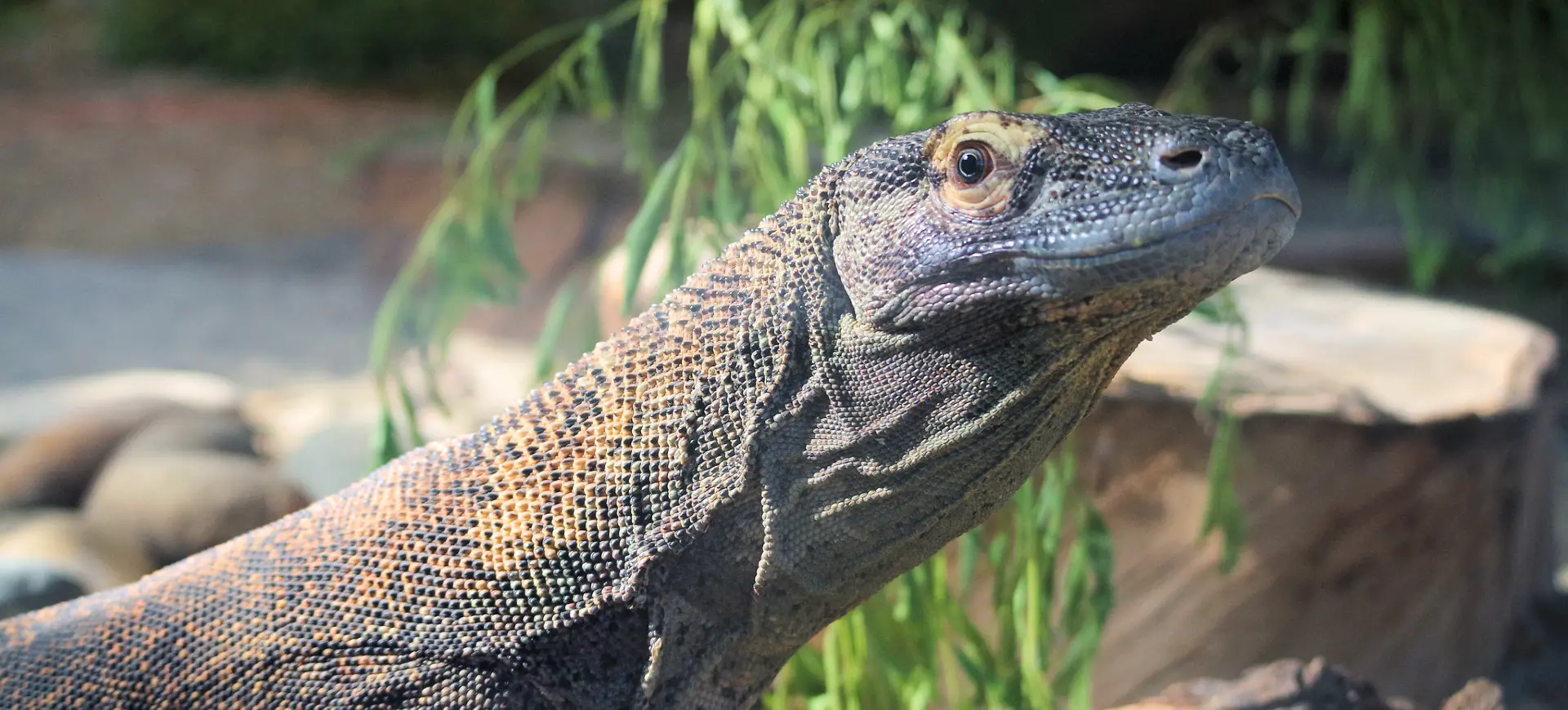Overview
The Asian water monitor (Varanus salvator) is a large, semi-aquatic lizard native to South and Southeast Asia. It is one of the largest lizard species in the world, second only to the Komodo dragon, and is known for its impressive size, adaptability, and strong swimming abilities. This species is highly versatile, thriving in various habitats, including wetlands, mangroves, forests, and urban areas, where it often scavenges for food. The Asian water monitor is an opportunistic predator and scavenger, feeding on a wide range of prey, from fish and amphibians to carrion and human waste.
This monitor lizard is a solitary and territorial species, with individuals defending specific areas, including water bodies and surrounding land. It is a strong swimmer, aided by its muscular tail, which it uses for propulsion in water and defense against predators. Despite its large size and intimidating appearance, the Asian water monitor is shy and will avoid humans unless provoked. Its ecological role as both a predator and scavenger makes it an important species for maintaining the health of ecosystems.
Asian water monitors are culturally significant in some parts of their range and are viewed with reverence and fear. While they are common in many areas, they face threats from habitat destruction, hunting for their skin and meat, and capture for the pet trade. Conservation efforts focus on protecting their natural habitats and ensuring sustainable coexistence with humans, particularly in urban areas where frequent conflicts occur.
Current distribution:
The Asian Water Monitor has a wide distribution across South and Southeast Asia, its range spanning countries like India, Sri Lanka, Indonesia, and the Philippines. This extensive geographic reach is a testament to the species' remarkable adaptability, which has enabled it to persist even in regions that have undergone significant changes due to human activities. Its versatility extends from natural habitats like wetlands and forests to human-modified landscapes, demonstrating the lizard's ecological resilience.
Despite its adaptability, the species faces habitat loss and fragmentation challenges, especially in areas experiencing rapid urban development. As forests are cleared and wetlands drained for agricultural or residential purposes, the availability of suitable habitats diminishes. This contributes to increasing stress on the population, necessitating attention from conservationists. Although the Asian Water Monitor has demonstrated considerable adaptability, the impact of ongoing environmental alterations presents a real concern for its future survival.
Physical Description:
The Asian Water Monitor boasts a robust, well-proportioned body with rough, keeled scales. The dorsal surface exhibits a complex pattern ranging from light to dark brown, punctuated with spots and stripes that serve as effective camouflage in its natural habitat. Complementing its body are a long neck and an even longer tail, which can be nearly twice the length of its torso. The tail not only aids in swimming but is also used as a defensive weapon when necessary.
The reptile’s limbs are muscular and designed for multifunctionality. Its strong claws are adept at both climbing trees and digging into the soil, allowing the lizard to traverse multiple types of terrain effectively. The Asian Water Monitor’s elongated snout is another defining feature, housing a forked tongue critical in its keen sense of smell. This olfactory ability is crucial for hunting and navigation, making the Asian Water Monitor a highly efficient predator.

Lifespan: Wild: ~15 Years || Captivity: ~20 Years

Weight: Male: 19-44 lbs (8.6-20 kg) || Female: 14-31 lbs (6.4-14 kg)

Length: Male: 78-100 in (198.1-254 cm) || Female: 59-78 in (149.9-198.1 cm)

Height: Male: 16-20 in (40.6-50.8 cm) || Female: 13-16 in (33-40.6 cm)

Top Speed: 12 mph (19.31 km/h)
Characteristic:
Native Habitat:
Asian Water Monitors are highly adaptable reptiles that thrive in various natural habitats. These habitats can vary from freshwater ecosystems like swamps and rivers to coastal mangroves rich in biodiversity. Their highly aquatic nature makes them exceptional swimmers capable of easily navigating these varied water bodies. When threatened, they often seek refuge in water, utilizing their robust tails as effective rudders for quick and agile propulsion.
In addition to their natural habitats, Asian Water Monitors also show a surprising adaptability to human-modified environments. They are frequently found in agricultural fields, hunting for smaller prey, and even in urban areas, coexisting with human populations. This flexibility in habitat selection indicates a remarkable ability to adapt to changing ecological conditions, thus allowing them to occupy a broad geographical range. It also underlines their resilience in increasing human encroachment into natural ecosystems.
Climate Zones:
Biogeographical Realms:
Continents:
Diet:
Diet & Feeding Habits:
The Asian Water Monitor primarily exhibits a carnivorous diet, feasting on a diverse range of prey, including fish, frogs, and small mammals like rodents. Employing its highly sensitive forked tongue, it can detect scent particles in the air, which allows it to locate and target its prey with remarkable efficiency. This specialized tongue acts as a chemosensory organ, offering the lizard an edge in tracking down food sources even in complex terrains such as wetlands and forests.
In addition to its preferred prey items, the Asian Water Monitor demonstrates opportunistic feeding behaviors. It is known to consume carrion when available, and its diet also includes smaller fare like insects and various types of eggs. This dietary flexibility enables the species to thrive in multiple ecological niches, highlighting its adaptability and resilience. The lizard’s diverse diet contributes to its survival and underscores its role as both a predator and a scavenger in its native ecosystems.
Mating Behavior:
Mating Description:
Mating in the Asian Water Monitor population predominantly occurs during the rainy season, aligning with conditions optimal for their offspring’s survival. Males identify receptive females through a specialized chemosensory mechanism, flicking their forked tongues to detect pheromones in the females’ scent marks. Once a receptive female is located, the courtship process ensues, characterized by physical nudges, tactile cues, and other non-verbal communications. The male then mounts the female to complete the copulation process, ensuring the fertilization of her eggs.
Following successful mating, females lay clutches of eggs, typically ranging from 10 to 50. The choice of nesting sites is crucial for the survival of these eggs, and females often opt for sandy or muddy substrates to facilitate temperature regulation. These environments not only provide a level of camouflage for the eggs but also ensure a stable temperature and humidity level, factors that are critical for the embryonic development of the offspring. The female’s role in selecting an appropriate nesting site underscores the complex reproductive behaviors exhibited by this species.
Reproduction Season:
Birth Type:
Pregnancy Duration:
Female Name:
Male Name:
Baby Name:
Social Structure Description:
Asian Water Monitors are predominantly solitary creatures, maintaining individual territories marked by scent glands near the throat and jaw. These scent markings serve as territorial boundaries, helping to minimize conflicts over resources like food and suitable sites for laying eggs. Social interactions among these monitors are typically limited and most commonly occur during the mating season. During these times, the monitors may engage in various complex behaviors to secure a mate, including physical displays and vocalizations.
Dominance hierarchies can emerge, particularly in areas where the population density of Asian Water Monitors is high. These hierarchies are established through various means, such as physical displays, confrontations, and sometimes combat. The dominant individuals usually have access to the best resources, including food and prime locations for laying eggs. These dynamic social structures may change over time due to various factors, including individual size, age, and health condition. Although primarily solitary, these social hierarchies and occasional interactions indicate social complexity within the species.
Groups:
Conservation Status:
Population Trend:
The Asian Water Monitor is currently classified as “Least Concern” on the IUCN Red List, primarily due to its extensive geographical distribution and high adaptability to diverse habitats. While exact population numbers are not rigorously documented, consensus among researchers suggests that the species has a stable population. Its wide-ranging diet and ability to thrive in natural and human-altered environments contribute to its resilience, making it less susceptible to immediate threats of extinction.
That said, the species is not completely immune to the challenges posed by human activities, particularly habitat loss and fragmentation. Areas undergoing rapid development and urbanization are of particular concern, as they directly impact the available natural habitats for these monitors. Additionally, these human activities can lead to increased human-animal conflict, posing another layer of threat to the species. Even though the Asian Water Monitor is categorized as Least Concern, ongoing vigilance is required to monitor its status, particularly in the face of accelerating habitat changes.
Population Threats:
The primary threats to the Asian Water Monitor stem largely from human activities that result in habitat destruction. Among these are agriculture, deforestation, and rapid urbanization, which lead to the loss of natural environments crucial for this species’ survival. As wetlands are drained, and forests are cut down to make way for farms, residences, and industrial facilities, the natural habitats for the Asian Water Monitor shrink, thereby putting strain on their populations. The fragmentation of habitats also restricts their movement, complicating foraging and breeding activities.
In addition to habitat loss, the Asian Water Monitor faces threats from hunting, primarily for their skin and meat. Their skin is highly valued for leather products, and their meat is considered a delicacy in certain cultural contexts. Such commercial exploitation further exacerbates the risks to their populations. If these activities continue without proper regulation or sustainable practices, they could pose a long-term risk to the species, undermining its current status as a species of “Least Concern” and potentially pushing it closer to a more endangered category.
Conservation Efforts:
Conservation efforts for the Asian Water Monitor are generally targeted at preserving its natural habitats and preventing illegal hunting activities. Many countries within its range have implemented legal protections that prohibit this species’ hunting, capture, and trade. These legislations often work with broader environmental policies to conserve crucial habitats like wetlands and forests. Regulatory bodies are put in place to enforce these laws and conduct regular surveillance to deter poaching and illegal trade, which are significant threats to the species.
Public awareness campaigns also play an integral role in the conservation strategy. These campaigns are designed to educate the public about the ecological importance of the Asian Water Monitor, highlighting its role in maintaining the health of ecosystems. By fostering a deeper understanding and appreciation of the species, such initiatives encourage coexistence between humans and these reptiles, particularly in areas where their habitats overlap with human settlements. Outreach programs often involve collaboration between government agencies, NGOs, and local communities to ensure effective and sustainable conservation efforts.
Additional Resources:
Fun Facts
- The Asian water monitor is the second-largest lizard in the world after the Komodo dragon.
- They are excellent swimmers and can stay submerged for up to 30 minutes.
- Their forked tongue is similar to snakes and is used to detect chemical environmental signals.
- They can climb trees when young but become more ground-dwelling as they grow.
- Asian water monitors can consume large prey, including small crocodiles and large fish.
- They use their powerful tails to swim, balance, and defend against predators.
- The species has adapted to urban environments, often scavenging in garbage dumps or urban waterways.
- Monitors can regrow lost tail tips, though the new growth may differ in appearance from the original tail.
- They are known for their intelligence and have been observed solving simple problems to access food.
- Their presence in urban areas often leads to fascination and fear due to their large size and appearance.


